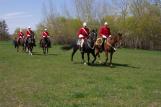3
In the summer of 1874, under the command of Colonel French, a recruited force of approximately 300 men departed Fort Dufferin on a long journey into the North-West Territories. The display of eagerness and spirit among the men showed just how sincere they were in establishing law and order over the whiskey trade on the western plains.With ox carts, wagons, field pieces, cattle, and horses in tow, the mounted troop traveled until they reached Roche Percee. It was at this rest point that Colonel French made a decision to split the group in two. One group headed west toward Fort Whoop-Up and the other, north to Fort Edmonton.
No matter what route or assigned troop, their travel was plagued with challenges that would deter any sane individual. The troops experienced rough terrain almost impassable; extreme drought were the only water found was stagnant brackish, murky puddles; the worst grasshopper infestation ever witnessed; frightening thunder storms that spooked their high-strung horses; and inevitably, sickness among the men from poor food and water.
The March West proved to be an unfriendly venture filled with challenges for both man and beast. Even though, their efforts and endurance are the beginnings and led the way for a network of 'Frontier' police detachments and patrols.
4
Preparations for the March West6
Colonel French has finally assembled his entire force and the march is ready to begin. The carefully selected recruits and their horses look fine, but are not prepared for life on the prairies.Bad food and lack of water soon lead to trouble for both men and horses and the march west becomes a nightmare for French and his men.
8
The two halves of the North West Mounted Police assembled at Fort Dufferin at last on June 19, 1874. The new recruits rode north from where the railway ended at Fargo, North Dakota. The other detachment rode south from Fort Garry.Colonel French expressed his pleasure in his force, particularly the new recruits and their fine, new horses especially selected for size and grace. Sergeant-Major Sam Steele, already a veteran of the prairies and a member of the Fort Garry group, expressed his admiration and the seeds of doubt: "The Left wing was composed of a fine, carefully selected and well-educated body of men with exceptionally good horses. These were all over fifteen and a half hands, with almost perfect forms, and were admitted in Toronto to be the best ever shipped from that city. But they were soon to have a hard time, and their perfect forms were reducted to living skeletons".
9
Getting Ready at Fort Dufferin11
Fort Dufferin, Manitoba:Published in Cdn Illustrated News, Oct 3, 1874
13
The force had been at Fort Dufferin just one day when the new horses caused some difficulty. A thunderbolt fell in the mist of the horses that night, causing them to stampede. Six men on guard were trampled under foot, wagons overturned, tents and equipment scattered.Says Steele: "I shall never forget that night. I had full view of the stampede, being not more than 50 yards from the horses as they rushed at the gate and attempted to pass it, scrambling and rolling over one another in one huge mass. This and the unceasing flashes of lightning, the rolling of the thunder, the loud shouts of the troopers as they vainly attempted to stop the horses and the mad gallop of Colmen's team, gave it a weird and romantic complexion, typically suggestive of the wild west."
All but one of the animals were soon returned, thanks to the calmer, mixed-breed broncos of the Fort Garry force. These western horses were smaller and less pretty, but better adapted to prairie life, and remained behind when the Toronto animals ran.
Steele and the other experienced riders used the broncos to round up the strays in just one day, although some ran as far as 100 miles.


